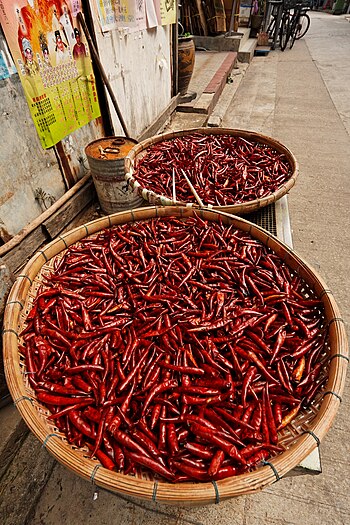 |
| Szechuan Shui zhu fish dish by Jiaqing Pan (Photo credit: Wikipedia) |
The province from which the cuisine that the world knows as Szechuan evolved is often hot and humid, and this contributed to this necessity of preparing foods in ways that differ significantly from other regions of China. Szechuan cuisine is primarily known for its hot and spicy dishes, though naturally there is more to Szechuan food than spice and sauces rich and strong in flavor.
A general overview of culinary history and trends reveals that, for the most part, areas that tended to spice heavily were areas in which the fresh food supply was not as reliable as in places that traditionally used a lighter hand in their use of spices. The climate of Sichuan is conducive to faster food spoilage. This, particularly in the past, made necessary food preservation techniques that themselves left behind a strong flavor, such as salting, pickling, drying, and smoking. Thus, spices served to mask the flavors of less than fresh foods and those that have been preserved by methods that affect their natural flavors. In addition to masking certain flavors, the use of hot spices, such as chili peppers, tends to be more common to hot climates, as the sweat that they can produce is thought to cool the body.
Much of the spicing of regional Chinese cooking is based upon bringing together five fundamental taste sensations – sweet, sour, pungent, salty and bitter. The balance of these particular elements in any one dish or regional cuisine can vary, according to need and desire, especially as influenced by climate, culture and food availability.
In Szechuan cuisine, there are a variety of ingredients and spices used to create these basic taste sensations. These include a variety of chili peppers, peppercorns over various types, Sichuan peppers, which are in reality a type of fruit, not pepper, and produce a numbing effect in addition to their warm flavor. Sichuan peppers, also called flower pepper and mountain pepper, are a traditional part of the Chinese five-spice powder, or at least of those that are modeled upon the most authentic versions of the spice combinations common to regional Chinese cooking.
Other ingredients used commonly in Szechuan cuisine to create the five fundamental taste sensations include different types of sugars, such as beetroot sugar and cane sugar, as well as local fruits for sweetness. The sour comes from pickled vegetables and different varieties of vinegar. A special bitter melon is added to many dishes to offer the touch of bitterness that complements other flavors. Other spices and flavors include dried orange peel, garlic, ginger, sesame oil and bean paste. Salt is important to Szechuan cuisine, and the area produces uniquely flavored salts that help to distinguish authentic Szechuan cuisine from the other regional cuisines from China.
Szechuan cuisine is marked by its rich traditional flavors, which stem from a culture of hundreds of years and are in part shaped by the natural forces of climate. Authentic Szechuan cuisine offers a unique dining experience made up of adventurous and creative taste sensations.







